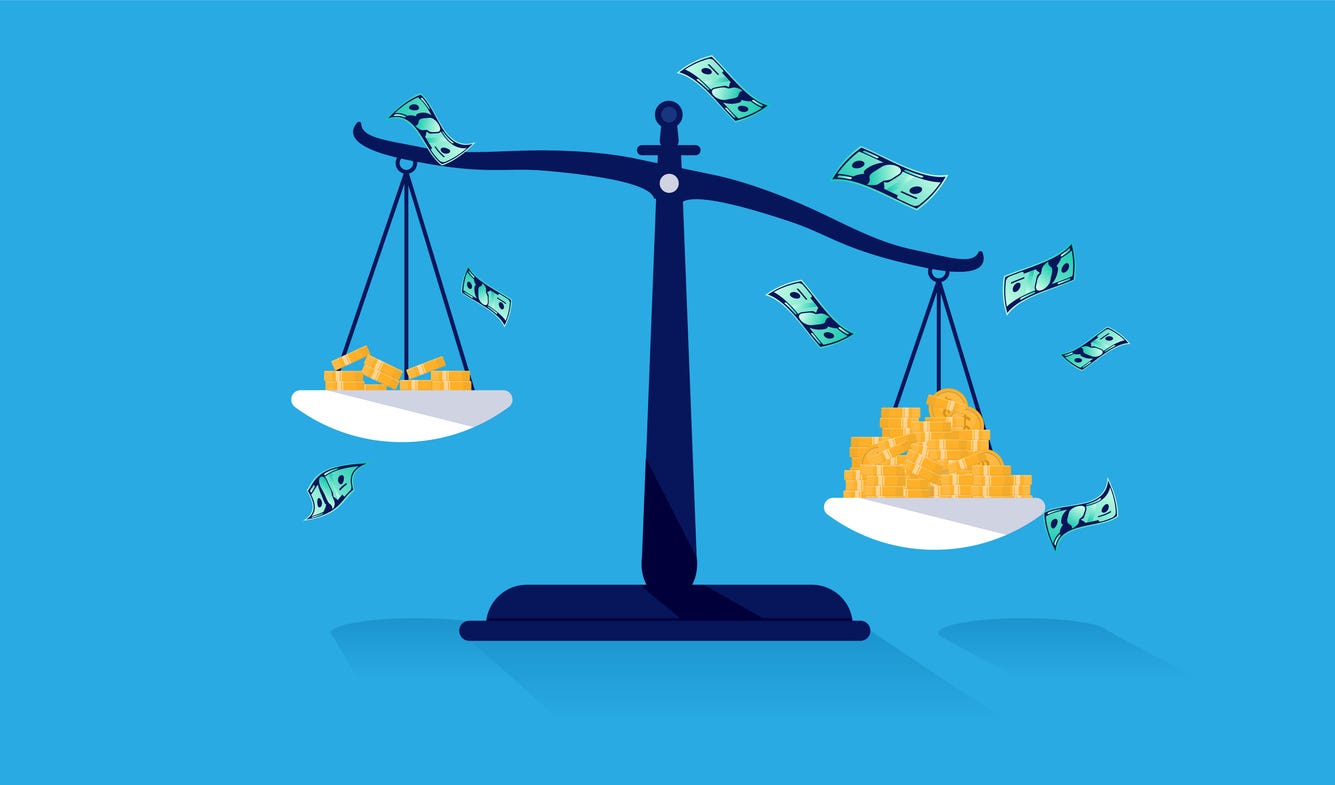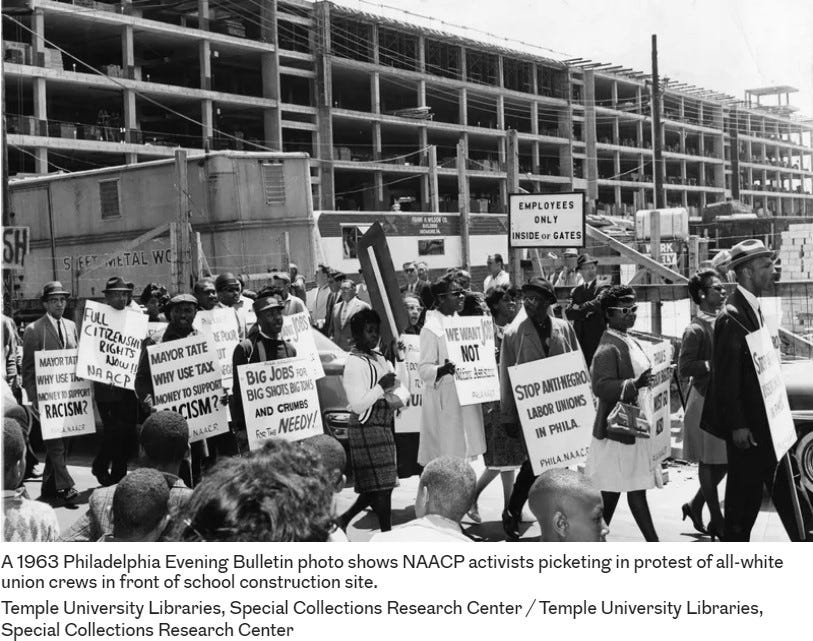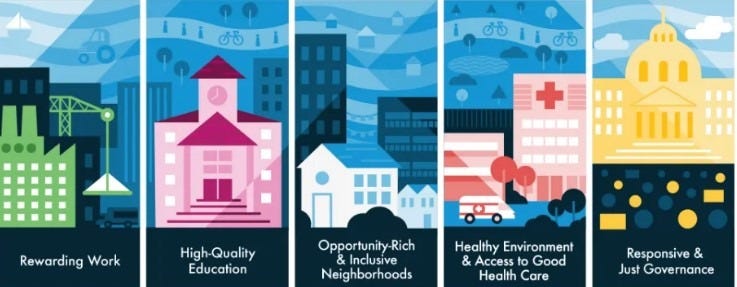The Fiction of Equal Economic Opportunity
The gaps & disparities between Whites and Blacks have not changed much in a half-century
One of America’s long-term myths, or can we call it what it is—a falsehood?—is that we live in a meritocracy where equal opportunity is available and accessible to everyone. In our 248-year history, it has never been true for so many groups, but especially for African Americans and Native Americans.
African Americans’ economic history in America has been an elongated story of oppression, exclusion, and discrimination. Everyone knows the obvious dimensions of the story—a long, horrific period of enslavement and the harsh and grim century of Jim Crow.
The Homestead Act
As we’ve seen in previous posts, the story included the granting of hundreds of millions of acres of land (an amount equal to the square acreage of California and Texas combined) to 1.6 million White families starting in 1862, lasting nearly 100 years, with most of the land given away in the program’s first 75 years. This was the Homestead Act. A scant few thousand Black families were given access to the program.
The Act has been described as “unquestionably the most extensive, radical, redistributive governmental policy in U.S. history. The number of adult descendants of the original Homestead Act recipients living in the year 2000 was estimated to be around 46 million people, about a quarter of the U.S. adult population.”[1] (emphasis added) Just to be clear: 46 million White people
The Creation of the Black Ghetto, plus the Exclusion from the New Deal & the GI Bill
It also included the White-led creation of the Black ghetto, which intentionally and severely limited Blacks from most economic opportunities.
The story involved the exclusion or, at best, very constrained participation in New Deal programs in the 1930s and 1940s and the GI Bill for home loans and career training in the 1940s and 1950s.
All those intentional exclusions provided massive benefits and advantages to Whites.
Redlining of Black Neighborhoods & the Gross Discrimination against Black Farmers
As did the formal and legal redlining of Black neighborhoods and greenlining of White neighborhoods throughout the U.S. for nearly a half-century (1930s-1970s) and more subtle and covert forms of both in the decades after. Throughout that time, banks almost always provided home mortgages to Whites in their neighborhoods but rarely to Blacks in their neighborhoods.
As did the gross discrimination against Black farmers from the Great Depression throughout the rest of the 20th century. What happened? For starters, during the Great Depression, the Federal Emergency Relief Administration (FERA) bailed out countless White farmers but hardly any African American ones.
Throughout the Great Migration (especially the 1930s to 1960s), White leaders and White farmers obtained thousands of economically troubled Black farms through unscrupulous, if not illegal, means. Discriminatory federal funding and private banking policies further excluded Black farmers from funding and benefits that White farmers received. Wealth for many White farm families compounded over the succeeding decades at the expense of Black farm families.
Once again, we saw continued immense benefits and advantages for Whites. Because of deliberate discrimination and exclusion, immeasurable disadvantage for Blacks.
Long-Time Exclusion from and Discrimination by Unions
What about unions? It had to be different with unions, right?
Well, the original National Labor Relations Act of 1935 allowed unions to exclude African Americans or diminish their participation and access to jobs. This exclusion and discrimination did not end formally for another three decades (roughly the early 1940s to the early 1970s) when unions were the strongest they have ever been in U.S. history and when union jobs were a pivotal passageway to the middle class for millions of Whites.
The federal government banned segregated unions within the government in 1962. Still, private-sector unions were not subject to those laws, and overt discrimination continued in numerous trades for another couple of decades.
Exclusion and discrimination were especially true in construction trades “during the home and highway construction booms . . . so black workers did not share with whites the substantial income gains that blue collar workers realized in the two big wage growth periods of the mid-twentieth century—war production and subsequent suburbanization.”[2]
Some blue-collar unions have continued to discriminate against their Black members. As recent as 2015, “New York’s sheet metal workers union began paying thirteen million dollars in compensation to African Americans who, although union members, received fewer job assignments than whites from 1991 to 2006.”[3]
These advantages for Whites have accumulated and compounded for two centuries. Yes, compounded like interest on an investment, accelerating the growth of White wealth and power. Compounded advantage makes it extraordinarily difficult for someone without it ever to catch up.
Fiction: Massive Opportunities Opened Up to Blacks Starting in the 1960s
We also have seen the fiction that since the 1960s, Blacks not only have substantial economic opportunities but also more opportunities than Whites have access to. And we’ve seen the accompanying falsehood that Whites are now discriminated against more often than Blacks.
If this weren’t such significant disinformation, it would be laughable.
America’s chronic and persistent economic exclusion, oppression, and discrimination of African Americans from the 1770s to the 1970s lubricated the pathways to greater wealth for tens of millions of Whites and sustained the path to poverty for millions of Black people.
How Did We Keep the Playing Field So Un-Level?
But what’s happened since the 1970s? Did America do anything differently and fundamentally to level the economic playing field for African Americans?
Throughout the 1970s and 1980s, in annual national polls, Whites did not believe the federal government should play any fundamental role to even the economic field for Blacks. Back then, a majority of Whites believed that Blacks just “needed to work harder” and “stop being so lazy.” They did not believe Blacks deserved any measure of so-called “affirmative action.” These beliefs persisted in comparable numbers for several more decades. And this occurred even though Whites, up until, say, 1970, received every economic advantage, as I recounted above.
As developers and suburban counties began expanding gateways out of the urban core out to suburbs across the nation, for several decades, they built them for Whites only (with few exceptions). As Whites left cities, so did millions of blue and white-collar jobs, decimating urban cores, where most African Americans remained. Untold numbers of jobs now existed that were geographically out of reach for most of them.
It's no surprise, then, that the Black unemployment rate, which was double that of Whites as the White flight to the suburbs began, has remained double the rate for the 60 years since.[4]
Is that unbelievable? Well, no, it is believable, but it is also unconscionable.
For most of that time, the unemployment level for Blacks has sat at recession levels; from the mid 1970s until the mid 1990s it persisted above 10% as it did from 2008-2016 (during and in the aftermath of the Great Recession).
Again, what did we do to level the field if the rate is still double what it was 60 years ago? Not enough, that’s for sure. Too many African American families still live in or near high-poverty neighborhoods, and too many of their children attend high-poverty, low-performing schools. Places of high poverty are places of low opportunity.
We also changed our laws and approaches to more severe forms of criminal justice in the 1970s through the early 2000s. As cities became decimated by the loss of jobs and industry, and not enough African Americans were able to move out of the ghettos, these neighborhoods became ripe for black markets in drugs and other criminal activity. Over those decades and continuing through today, too many Black teens and young men (and women) ended up in jail and prison, many for lengthy sentences for simple drug possession and petty drug dealing.
This led quickly to what’s become known as mass incarceration, which lawyer and author Michelle Alexander has characterized as “The New Jim Crow.”[5] At various times, this dynamic took more than one million Black men and women out of the job marketplace. Even when they completed their sentences, our economic system constrained the ability of returning citizens to access the jobs marketplace, let alone decent housing and other basic necessities.
The Unconscionable Gaps and Can They Be Overcome?
As a result of these factors and more, we’ve seen …
The income gap between White and Black households grow from $20,000 in the 1960s to about $31,000 in 2019;[6]
The wealth gap between Whites and Blacks, which was 10:1 in 1968, remain at that level as recently as 2023.[7]
As stunning as this profound lack of economic progress is, even more stunning to me is this fact:
Black adults are paid significantly less than White adults at every education level, from lack of a high school diploma to an advanced degree.
The lower pay is not a matter of a few percentage points at each level. It’s above 20% for lack of a high school diploma, having a high school diploma only, having some college, and having a college degree. It is a slightly smaller gap for those with advanced degrees.
Yet so few people know this.
Indeed, I didn’t until I started the research for my book in 2020.
Let’s remember that the news on these issues isn’t all bad. During the Biden Administration, the nation has seen the total number of prime-age workers employed for Black men and women rise to its highest level ever: 14.5 million, 2 million above where it was in 2019.
We also understand better what lifts households out of poverty, which is critical when nearly 27% of households in America live on incomes that are at only double the poverty level and where the poverty rate for African Americans is 2.5 times that of the national average. I briefly explored The Urban Institute’s Upward Mobility for Poverty framework earlier in October, explaining the key elements needed for Americans to climb out more effectively. https://levelthefield.substack.com/p/the-investments-we-need-to-make-in
Whites & the So-Called Reverse Discrimination
Despite the enormous economic gaps between Whites and Blacks, too many Whites in America feel aggrieved.
For example, as recently as October 2022, 65% of White Republicans said discrimination against White people is as big a problem as what other races face. Further, only a third of White Republicans believe that African Americans strengthen American society, a percentage less than that for Latino Americans (37%) and far less than that for Asian Americans (52%).[8]
With this backdrop, we know that leveling the economic playing field significantly will be a steep climb. To make that climb, we must address head-on the falsehood that White people are now the major victims of economic (and social) discrimination.
FOOTNOTES
[1] Keri Leigh Merritt, “Land and the roots of African-American poverty,” aeon, March 11, 2016, https://aeon.co/ideas/land-and-the-roots-of-african-american-poverty.
[2] Richard Rothstein, The Color of Law, New York, NY: Liveright Publishing Corporation, 2018, p. 161.
[3] Ibid, p. 169.
[4] Olugbenga Ajilore, “On the Persistenc of the Black-White Unemployment Gap, Center for American Progress, February 4, 2020, https://www.americanprogress.org/article/persistence-black-white-unemployment-gap/.
[5] Michelle Alexander, The New Jim Crow : Mass Incarceration in the Age of Colorblindness, New York :New Press, 2010.
[6] John Herbers, “Income Gap Between Races Wide as in 1960, Study Finds,” The New York Times, July 18, 1983, https://www.nytimes.com/1983/07/18/us/income-gap-between-races-wide-as-in-1960-study-finds.html and “Racial Economic Inequality,” Inequality.org, 2024, https://inequality.org/facts/racial-inequality/#racial-income-inequality.
[7] Nine Charts about Wealth Inequality in America,“ Urban Institute, April 25, 2024, https://apps.urban.org/features/wealth-inequality-charts/.
[8] “Challenges in Moving Toward a More Inclusive Democracy: Findings from the 2022 American Values Survey,” The Public Religion Research Institute (PRRI), October 2022, https://www.prri.org/research/challenges-in-moving-toward-a-more-inclusive-democracy-findings-from-the-2022-american-values-survey/.








